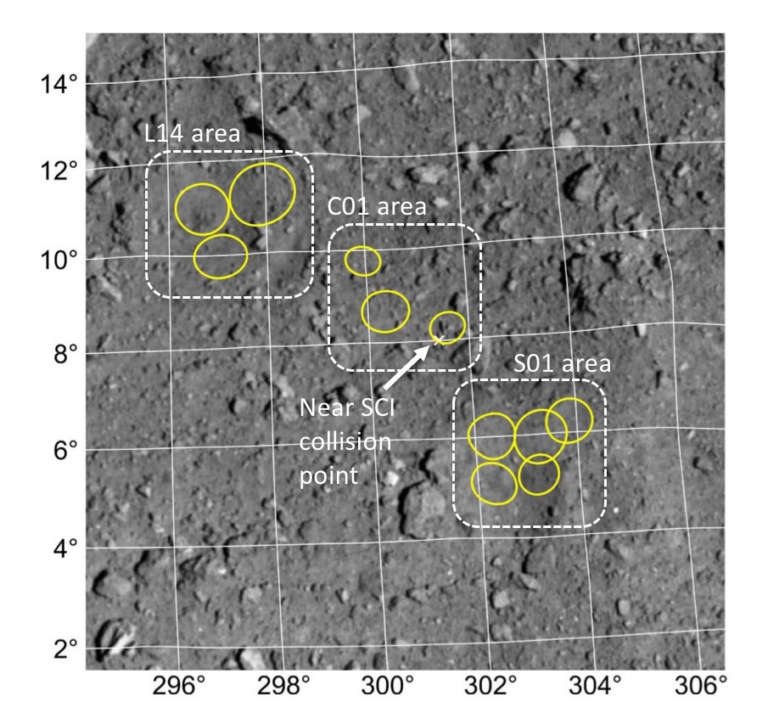Jason Davis • May 21, 2019
Hayabusa2 Encounters Snag Trying to Drop Second Target Marker
Japan's Hayabusa2 spacecraft aborted an attempt to drop a second target marker on the surface of asteroid Ryugu last week. The target marker was intended to guide the spacecraft during a possible second sample collection attempt.
Hayabusa2 is healthy and has since returned to its 20-kilometer home position. JAXA overcame a similar abort last year by making some minor procedural changes, but the clock is ticking—Hayabusa2 only has about a month and a half left before Ryugu gets too hot for any more touchdowns.
Hayabusa2, Japan's mission to Ryugu and other asteroids
Hayabusa2 traveled to the asteroid Ryugu, deployed rovers on its surface, and brought samples back to Earth.
Following the mission's first sample collection in February 2019 and the creation of an artificial crater in April, JAXA is debating whether to try and collect a second sample from Ryugu. The risks include more of the same hazardous terrain that made the first touchdown a dicey proposition, as well as the possibility that more debris could stick to the spacecraft's navigation cameras, clouding their views.
In preparation for the possible touchdown, Hayabusa2 descended to Ryugu from 14 May to 16 May to release another target marker. The spacecraft uses these reflective balls, which contain the names of Planetary Society members and other worldwide well-wishers, to help guide the spacecraft during close-proximity operations.
The target marker would have been dropped at about 02:42 UTC spacecraft time on 16 May, from roughly 10 meters above an area named S01. S01 is just a few meters away from the artificial crater that Hayabusa2 created during the SCI operation, and likely contains material unearthed (unasteroided?) by the impact. A sample from here would allow scientists to study material from just beneath Ryugu's surface that has been less exposed to space weathering than the material that Hayabusa2 collected previously.

Last week’s target marker operation started out just fine. As usual, Hayabusa2 sent home pictures in real-time during its descent, including this shot that shows the spacecraft’s shadow from about 60 meters over the surface:

But then, at just 50 meters away, Hayabusa2 automatically stopped the descent and began backing away from Ryugu.
[PPTD-TM1] The spacecraft descent has been autonomously aborted at an altitude of about 50m. Hayabusa2 is currently rising to the home position. Telemetry from the spacecraft has been confirmed and the spacecraft is normal, but the target marker has not been dropped.
— HAYABUSA2@JAXA (@haya2e_jaxa) May 16, 2019
At this height, Hayabusa2 would have still been using LIDAR to determine its altitude (it switches to a short-range laser finder at 35 meters), descending at 10 centimeters per second. JAXA has not yet said what happened, but a similar abort happened during a touchdown rehersal in September 2018. In that instance, the spacecraft aborted at 600 meters when the LIDAR had trouble picking up signals bounced back from Ryugu due to the asteroid’s very low reflectivity. The mission team was able to adjust their procedures and overcome those problems, so there’s a good chance that can happen again.
The problem, though, is that Ryugu is approaching perihelion, and its surface temperature will start to climb. Once it tops 100 Celsius, as soon as early July, the spacecraft won't be able to spend time in close proximity to Ryugu because all that radiated heat is hard on the spacecraft.
So, if Hayabusa2 is going to collect a second sample, it needs to do so in the next month and a half. The spacecraft will stay at Ryugu until November or December of this year, when it departs for Earth. It will return home with its samples in late 2020.
Support our core enterprises
Your support powers our mission to explore worlds, find life, and defend Earth. You make all the difference when you make a gift. Give today!
Donate

 Explore Worlds
Explore Worlds Find Life
Find Life Defend Earth
Defend Earth


